A Writer's Room of One's Own
( This is a long post. If it's truncated by your e-mail service, click "read the whole message")
In her often-quoted essay, "A Room of One's Own," Virginia Woolf argued that for a woman to write fiction, she must have money and a room of her own. I may not have a lot of money but depending on my mood, I do seek a dedicated space in which to work, carving out a sanctuary for my thoughts and imagination to bloom.
Since I live on a boat I have many spots where I like to settle down and write, depending on my mood, the weather, or task at hand. At night while I’m in bed and reading a book on my iPad my dog, Zippy, sleeps beside me. As Fall sets into San Francisco’s East Bay, and the skies color gray, I often I wedge myself into a small space, a transformed V-berth forward on my boat from which I removed the cushions where guests are supposed to sleep. My marine mechanic crafted a small piece of wood that fits neatly in place between the two berths and holds my laptop. A monitor rests in front of me on what was once a berth. It’s rather messy with files stored in plastic bins. But it’s a psychological haven, free from distractions.which makes me feel like an astronaut crammed into their space-capsule. Zippy sleeps on a cushion on the floor.
But one thing I do know, I could never work in a home office like Tina Fey, surrounded by papers and children. In fact, I don’t know how mothers get anything done at all.
Virginia Woolf’s “writing lodge” in the garden of her home
Virginia Woolf toiled here in a “lodge” built in the garden of the Woolf’s Bloomsbury home, writing preliminary drafts with pen and ink. Leonard Woolf described his wife’s writing room in earlier years when the couple created Hogarth Press,
In Virginia’s workroom there was always a very large, solid, plain wooden table covered with filth packets, papers, letters, manuscripts, and large bottles of ink. She very rarely sat at this table, certainly never when she was writing a novel in the morning. To write her novel of a morning she sat in a very low armchair, which always appear to be suffering from prolapsus uteri; on her knees was a large board made of plywood which had an inkstand glued to it, and on the board was a large quarto notebook of plain paper which she had bound up for her and covered herself in (usually) some gaily-colored paper. The first draft of all of her novels was written in one of these notebooks with pen and ink in the mornings . . .Her room tended to become not merely untidy but squalid. At the back of the house was what had once been an immense billiard room. We used it as a storeroom for the Hogarth Press and there embedded among the pyramids and mountains of parcels, books, and brown paper sat Virginia with her disemboweled chair, her table, and her gas fire.
In evenings, when stumped or anxious, I sometimes work with glue, paper, tweezers and balsa wood to construct miniature rooms from kits imported from China. The process is calming, a form of meditation. Here’s one I just assembled of Hemingway’s office, 12” high.
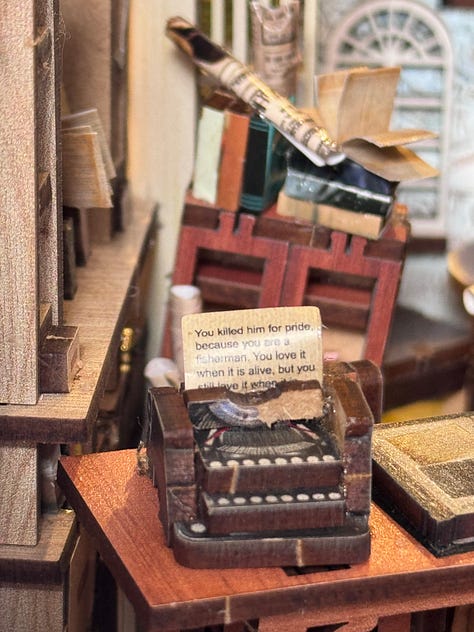
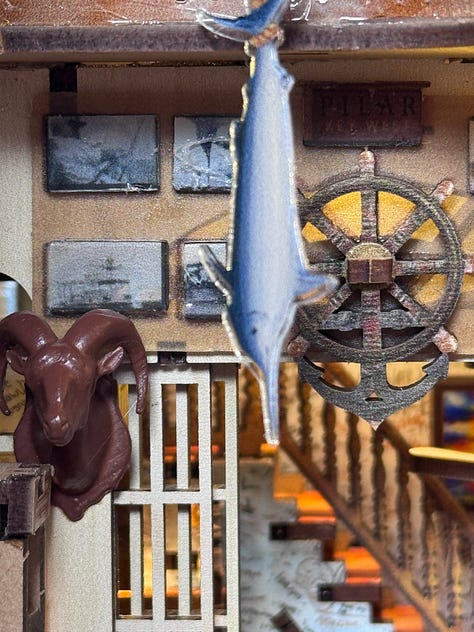
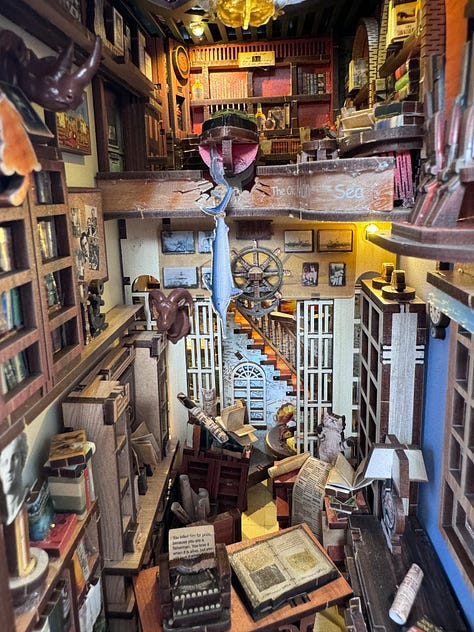
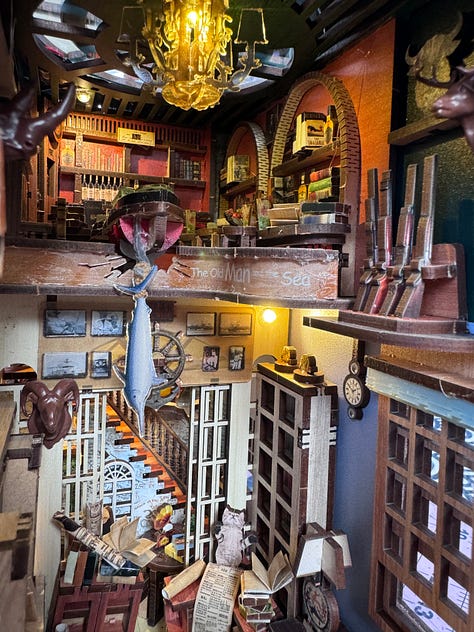
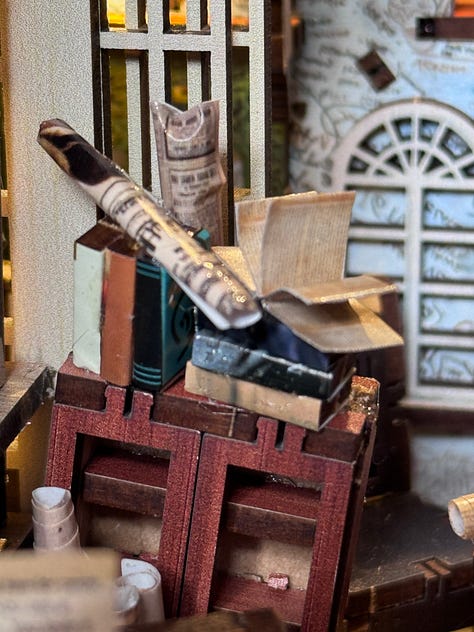
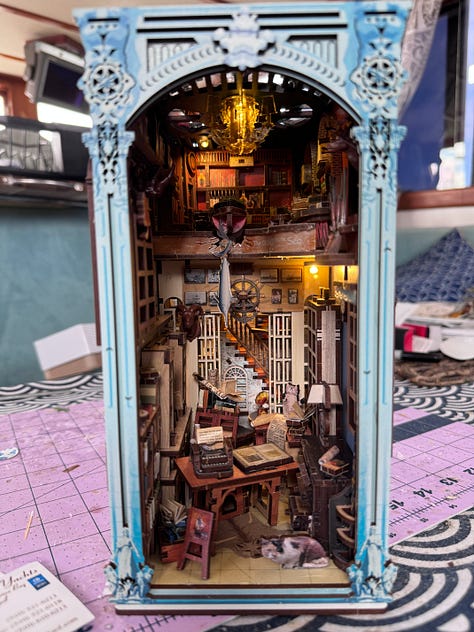
Hemingway’s office in miniature: a kit from China assembled by Stephenie Hollyman
Some days in search of companionship, I work in a my favorite coffee shop surrounded by silent remote workers tethered to their screens. On a sunny day on my boat, I may arrange my computer monitor , a keyboard and MacBook Pro on the dinette in my boat’s galley where light splashes in. There I can watch marina traffic move to and fro. At day’s end I may marvel at the sunset reflected in the doorway to my boat.
My boat’s “room” with a view
E.B. White at work in Maine
E.B. White's cozy and simple office reflected his personality and literary style After all, this was the man in “Elements of Style” who urged writers to strip the superfluous from their work. Located in his farmhouse in Maine, White’s office was filled with books, manuscripts, and personal mementos. The desk, often cluttered with papers and typewritten drafts, served as a workspace where he crafted his beloved essays for The New Yorker and children's stories, including "Charlotte's Web".
White became a staff writer at The New Yorker in 1927, but was an early enthusiast of the work-from-home movement, initially refusing to come to the office and eventually agreeing to come in only on Thursdays. In those days, he shared a small office (“a sort of elongated closet,” he called it) with James Thurber. His famous officemate later recalled that White had a brilliant habit: When visitors were announced, he would climb out the office window and scamper down the fire escape. “He has avoided the Man in the Reception Room as he has avoided the interviewer, the photographer, the microphone, the rostrum, the literary tea, and the Stork Club,” Thurber later remembered of the chronically shy author. “His life is his own.”
Mark Twain’s writing room with a pool table where he played or used it as a desk.
Jane Austen’s writing desk
It’s hard to believe that Jane Austen was able to write Emma, Persuasion, and a revision of Pride and Prejudice on this small table. You can read all about this writer’s who worked on a tiny table on this site from a a Morgan Library exhibition, “A Woman’s Wit”. One wonders how the process of writing with a feather quill needing to be dipped in ink, affected her writing process. The Jane Austen Manuscript Project opines that,
Handwriting, by contrast, happily accommodates the quirks and inconsistencies of individual expression, taste, and personality, and a range of letter-shapes that grow and diminish in size regardless of rules of upper and lower case.
The office for playwright George Bernard Shaw
George Bernard Shaw kept it it simple, the website Write Life, tells us, with a typewriter, a clean white desk and a small window in a private place. That last one was key for Shaw, who once confessed, “People bother me. I came here to hide from them.”
For me, whether it’s a the cubby-hole I created forward on my boat, tapping on my laptop in a coffee shop or writing on my galley’s table, what matters most is that I’m productive, letting e-mails that should be answered lay languid.
How about you?
Share your thoughts in the comments!

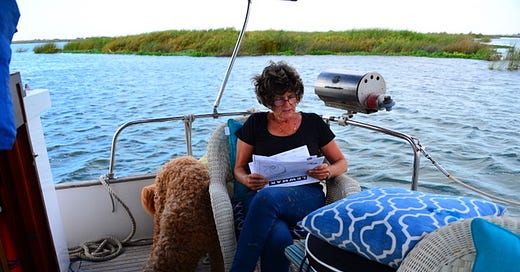



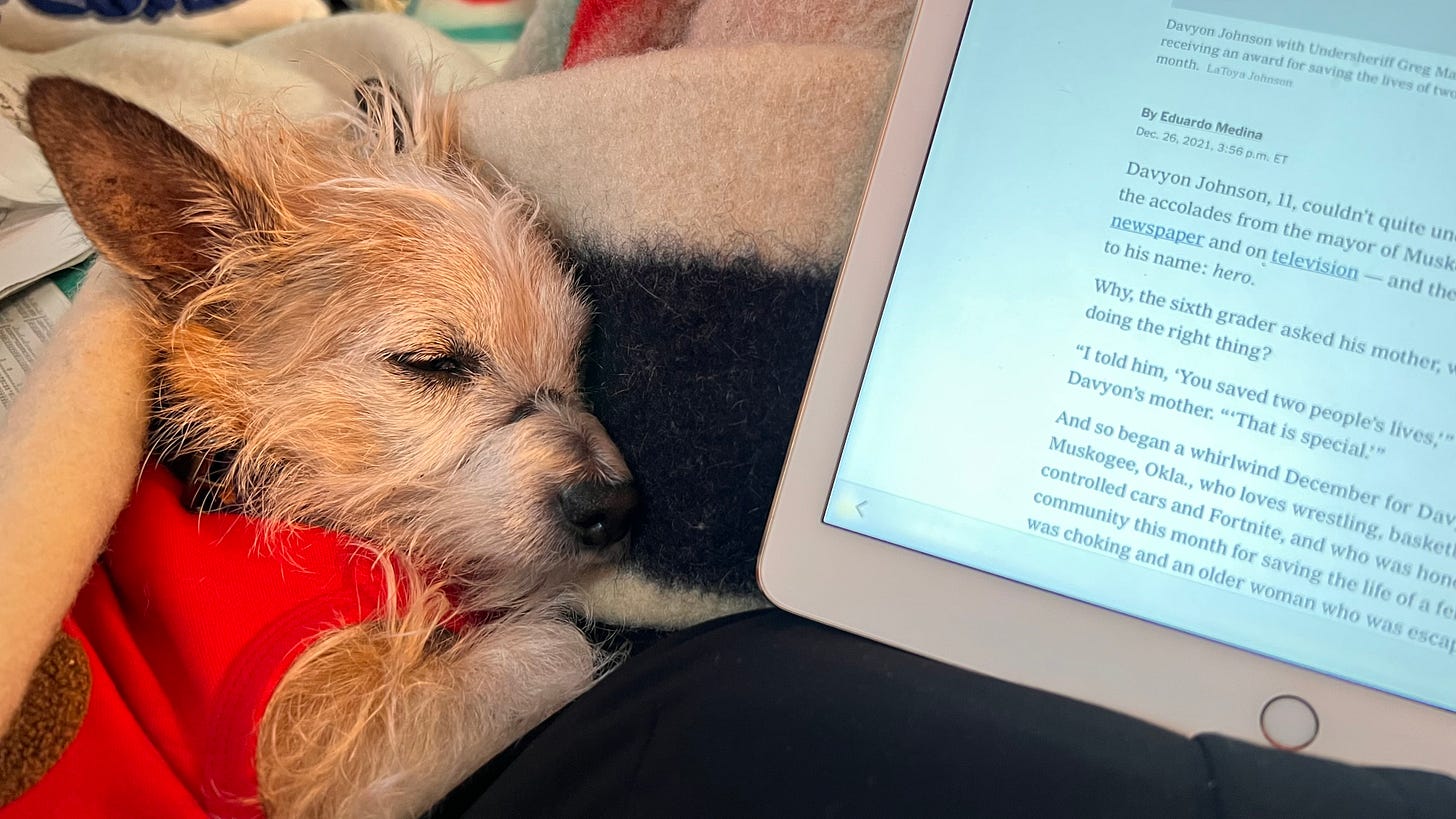







I gave it to Aaron who loves Hemingway. He has it on his canvas shop.
Nice Stephanie! I just finished A Movable Feist. Seems writing is calling me again! I love the miniature of Hemingways office! But, where do you put it!? (I’ve been aboard your tug!) 🙏🏻☮️